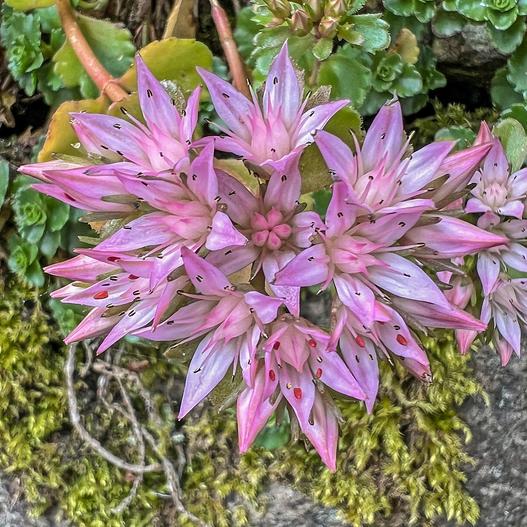Caucasian Stonecrop
(Phedimus spurius)
Caucasian Stonecrop (Phedimus spurius)
/
/

Tim Green
CC BY 2.0
Image By:
Tim Green
Recorded By:
Copyright:
CC BY 2.0
Copyright Notice:
Photo by: Tim Green | License Type: CC BY 2.0 | License URL: https://creativecommons.org/licenses/by/2.0/ | Uploader: Tim Green aka atoach | Publisher: Flickr




























































Estimated Native Range
Summary
Phedimus spurius, commonly known as Caucasian Stonecrop, is a semi-deciduous perennial herb native to rocky outcrops and alpine meadows in West Asia and the Transcaucasus region. It typically grows to a height of 0.3-0.5 feet (0.09-0.15 meters) and spreads up to 2 feet (0.6 meters) wide. This groundcover plant forms mats of succulent leaves and produces clusters of star-shaped flowers in shades of yellow, which can sometimes appear in orange, pink, purple, red, and white during the summer months. The flowers are moderately showy and attract pollinators.
Caucasian Stonecrop is valued for its drought tolerance and ability to thrive in poor soils, making it an excellent choice for rock gardens, green roofs, and as a ground cover in xeriscaping. It is also used in border fronts, slopes, and for erosion control. This plant prefers full sun but can tolerate light shade and requires well-drained soil. It is generally low-maintenance but can be susceptible to root rot in overly moist conditions. While it is a useful ornamental plant, Phedimus spurius can become invasive outside its native range, so gardeners should consult local guidelines before planting.CC BY-SA 4.0
Caucasian Stonecrop is valued for its drought tolerance and ability to thrive in poor soils, making it an excellent choice for rock gardens, green roofs, and as a ground cover in xeriscaping. It is also used in border fronts, slopes, and for erosion control. This plant prefers full sun but can tolerate light shade and requires well-drained soil. It is generally low-maintenance but can be susceptible to root rot in overly moist conditions. While it is a useful ornamental plant, Phedimus spurius can become invasive outside its native range, so gardeners should consult local guidelines before planting.CC BY-SA 4.0
Plant Description
- Plant Type: Herb, Succulent
- Height: 0.3-0.5 feet
- Width: 1.5-2 feet
- Growth Rate: Moderate
- Flower Color: Pink, Purple
- Flowering Season: Summer
- Leaf Retention: Deciduous
Growth Requirements
- Sun: Full Sun
- Water: Low, Medium
- Drainage: Fast, Medium, Slow
Common Uses
Bee Garden, Bird Garden, Border Plant, Butterfly Garden, Deer Resistant, Drought Tolerant, Erosion Control, Fire Resistant, Groundcover, Low Maintenance, Rabbit Resistant, Rock Garden, Salt Tolerant, Showy Flowers, Street Planting
Natural Habitat
Rocky outcrops and alpine meadows in West Asia and the Transcaucasus region
Other Names
Common Names: False Stonecrop , Two-Row Stonecrop , Rød Stenurt , Kaukasus-Fetthenne , Orpin Bâtard , Orpin Pourpre , Gravfetblad , Kaukasiskt Fetblad , Tworow Stonecrop , Unechte Fetthenne
Scientific Names: Phedimus spurius , Sedum spurium var. coccineum , Sedum denticulatum , Sedum spurium
GBIF Accepted Name: Phedimus spurius (M.Bieb.) ’t Hart